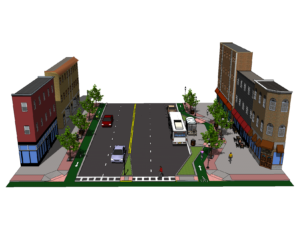The Cuyahoga County Planning Commission, the Cuyahoga County Department of Public Works, and the Office of the County Executive have been working together with our regional partners to help municipalities throughout the County learn what complete streets are all about and how they can benefit by implementing or adopting their own policies.
 The result of our collaboration is this Complete Streets Toolkit (PDF). The Cuyahoga County Complete Streets Toolkit guides community leaders, planners and engineers through the implementation of complete streets. To facilitate community leaders in re-imagining their road planning process, this Toolkit outlines an alternative planning and design process for complete streets that is based on context sensitive solutions. Intended to help local municipalities assess their current road types and assist them with developing a complete streets policy and/or project; the Toolkit explains and illustrates the concepts of complete streets then provides design options that can be tailored to each community’s specific needs.
The result of our collaboration is this Complete Streets Toolkit (PDF). The Cuyahoga County Complete Streets Toolkit guides community leaders, planners and engineers through the implementation of complete streets. To facilitate community leaders in re-imagining their road planning process, this Toolkit outlines an alternative planning and design process for complete streets that is based on context sensitive solutions. Intended to help local municipalities assess their current road types and assist them with developing a complete streets policy and/or project; the Toolkit explains and illustrates the concepts of complete streets then provides design options that can be tailored to each community’s specific needs.
We invite you to use this Toolkit to guide municipal road projects or even develop a policy for your own community and help us make Cuyahoga County a healthier and more sustainable place to live, work and play. The Toolkit serves to bridge the gap between road projects that primarily serve vehicular users to projects that serve multiple users of the road, including but not limited to pedestrians, bicycles, and transit riders.
How to Use the Toolkit
The Toolkit is intended as a “how to” manual for engineers, planners, and local elected officials. It is comprised of five chapters structured as follows:
Chapter 1 gives an overview of the benefits and perceived challenges of complete streets.
Chapter 2 outlines the factors to consider when planning road projects, such as the local transportation context and existing street network, and helps communities identify opportunities for complete streets treatments from road maintenance to new construction.
Chapter 3 showcases section drawings for different types of streets and highlights how components of complete streets designs and amenities can be included in specific projects.
Chapter 4 goes into more depth on each of the amenities discussed in Chapter 3. A short description of each amenity is provided in order to create a unified language for complete streets planning that will facilitate and foster conversations between engineers, planners, elected officials, and citizens throughout the county.
Chapter 5 provides a strategic framework for implementing complete streets policies and projects. From involving city/village departments, through building expertise and support, to changing procedures and financing projects, Chapter 5 provides a “How to Manual” on getting complete streets projects built.
The Toolkit relies heavily on material available from the National Complete Streets Coalition, and references are provided throughout the Toolkit for additional resources. For further questions, training, and inquiries about the toolkit, please contact the County Planning Commission and Cuyahoga County Department of Public Works.
